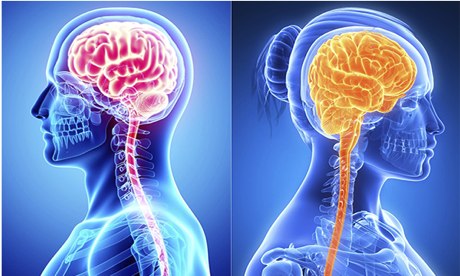
The short answer is yes. The longer answer is that men express emotions (like empathy) differently than do women. Here is the even longer answer:
[I]n another study, male and female teens gave self-reports and had several physiological measures taken while they viewed animated clips depicting people being hurt. Female participants scored higher than males on self-reported empathy, and this sex difference increased with age. But no sex differences were detected in blood pressure, heart rate, or pupil dilation—all measures of emotional responsiveness. These results suggest that males and females feel the same thing, but report what they feel differently.These results, and many others like them, lend credibility to the social construction model that suggests many of the differences between males and females are socialized into each gender but are not inherent in either sex.
Are Males and Females Equally Emotional?
The sexes experience emotions the same but process them differently
Published on June 23, 2014 by Denise Cummins, Ph.D. in Good Thinking
In a previous blog, I discussed why some people seem to lack empathy. The short answer is that empathy (feeling distress when viewing another's pain) can be exhausting and lead to burnout, so some people cope by distancing themselves from those who are suffering. I also reported the intriguing results of a study that showed compassion can be trained as a highly effective coping strategy to overcome empathic distress and strengthen resilience. Rather than feeling overwhelmed by the suffering of others (as happens in empathy), compassion allows one to feel concern for another's suffering. This frees us to effectively offer help and to derive peace and satisfaction from acting to reduce the suffering of others.
In that study, however, all participants were female. That might lead the inquiring reader to wonder why the researchers chose to exclude men and whether the results apply to men as well.
Do Men and Women Feel Empathy Equally?
While this seems like a straightforward question, the answer is not. Countless studies have been conducted to address this question, with conflicting results. For example, one study followed the social development of over 500 teenaged boys and girls for six years. The measures they looked at included empathic concern and the ability to see emotional situations from another person's perspective. Girls outpaced boys on both measures.
We might conclude from this that females are indeed more empathetic than boys. But the difficulty is that this study (like most studies on empathy) relied on self-report: Participants simply reported how distressed they felt or how easy or hard it was see things from the other person's perspective. When physiological measures are taken, however, these sex differences tend to disappear. For example, in another study, male and female teens gave self-reports and had several physiological measures taken while they viewed animated clips depicting people being hurt. Female participants scored higher than males on self-reported empathy, and this sex difference increased with age. But no sex differences were detected in blood pressure, heart rate, or pupil dilation—all measures of emotional responsiveness. These results suggest that males and females feel the same thing, but report what they feel differently.
There is more scientific agreement, however, with respect to sex differences in how emotions are processed. A number of studies have reported that males and females recruit different neurocircuitry when processing and "down-regulating" (blunting) emotions.
A recent study led by Dr. Yoshiya Moriguchi of the National Institute of Mental Health shows this quite clearly.
Adult men (n = 17) and women (n = 17) viewed images that typically arouse strong positive or negative emotional reactions. While viewing the images, they rated their moment-to-moment feelings of subjective arousal and underwent fMRI brain scans.
The results showed quite clearly that men and women did not differ overall in their intensity of moment-to-moment emotional reactions to the images. But the neural circuitry recruited during emotion processing differed between the sexes. Women showed neural activity in the anterior insula cortex, which processes bodily sensations. This means that they deeply experienced emotions within their bodies. Men, on the other hand, showed neural responses in the visual cortex. While processing these images, male brains immediately activated circuitry involved in regulating shifts of attention to the world (i.e., the dorsal anterior insula cortex and the dorsal anterior cingulate cortex). This allowed them to shift the emotional impact of the images away from themselves.
Is this automatic shifting of emotional impact away from oneself adaptive? Well, it depends. On the one hand, women risk emotional overwhelm and burnout if they repeatedly experience distress within themselves at the sight of others in distress. So distancing oneself from others' pain may be adaptive to mental and emotional well-being. On the other hand, such distancing also allows one to ignore the pain of others or to freely inflict such pain with little distress to oneself. Such distancing may be adaptive for combat, torture, or cruelty, but can prove problematic for developing prosocial competences.
In either case, this research suggests that compassion training is warranted for both sexes. Such training allows both sexes to learn to disengage in a manner that fosters benevolent action rather than succumbing to overwhelm or resorting to uncaring dissociation.
Copyright Dr. Denise Cummins June 24, 2014
Dr. Cummins is a research psychologist, a Fellow of the Association for Psychological Science, and the author of Good Thinking: Seven Powerful Ideas That Influence the Way We Think.
No comments:
Post a Comment